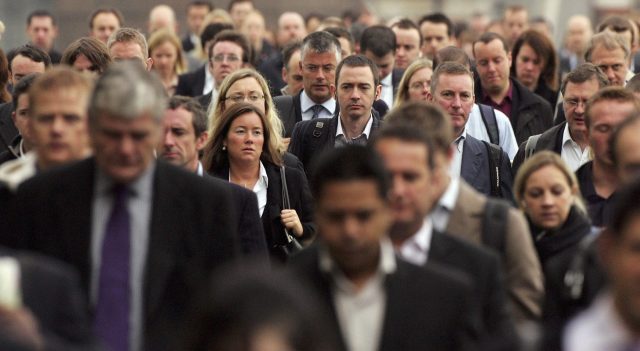Credit: Scott Barbour

In many ways the world has never been better. On a whole range of demonstrable, provable, quantifiable matters life over the last quarter century has just kept on improving.
Take just a few of the figures cited by the Swedish author Johan Norberg, in his 2016 book Progress: Ten Reasons to Look Forward to the Future. Norberg cites the work of international bodies analysing levels of global hunger, poverty, illiteracy and child mortality between 1990 and 2015. This 25-year period saw one of the fastest changes in global history. In the course of a quarter of a century hunger fell by 40%, child mortality and illiteracy fell by more than 50% and poverty decreased by more than 70% during the same period. In the US, to take just one case, even pollution massively decreased (by 60%) during this same period. If these trends were to continue for another quarter century then issues which have blighted the human species since we first evolved could within the lives of people now living actually get solved – or at the very least managed – at levels which would have been unimaginable in any previous generations.
And yet polling of public opinion shows a stark trend in a different direction. As the global situation demonstrably improves the public believe that everything is in fact going very much the other way.
Ipsos MORI have just highlighted one piece of striking recent research[1. https://twitter.com/IpsosMORI/status/938492368659116033] discussed in yesterday’s UnHerd podcast. It asked people to identify which of three statements was closest to their view. The statements were (1) The world is getting better (2) The world is getting worse (3) Neither of those.
The poll found that across all the diverse countries polled only 13% of the public think that the world is getting better. The most positive public in the world was in China where fully 53% of people think that the world is getting better. But China is the only country polled in which more than half of the public felt this way. The next highest-ranking country, India, saw 43% of the public feeling in such a way. Then a swift fall-away to the next most optimistic public – the Swedes, on 23% – and the Americans, on 16%.
At the other end of the spectrum a mere 3% of Belgians agreed with the same statement, mingling with the gloomy publics of Japan, Italy and Mexico (all on 4%). In Western Europe the British public look surprisingly optimistic. In Britain fully 9% of the general public think the world is getting better. Yet 67% think it is getting worse. From the Swedes on down, the majority of the publics found that the statement ‘The world is getting worse’ was closest to their views: 57% in Sweden, 63% in the US, 63% in Australia, 81% in Italy and 83% in Belgium. Only small percentages of people held no strong view on the future.

As so often, it is possible to conjure up any number of explanations for the gap between one set of realities and the perceptions across the world. The most common – which advocates of capitalism and free markets are especially prone to – is to say that the gloomy publics simply need to be better informed about the realities of the world around them. Advocates of this point of view presume that the public are wrong and that what they are suffering from is a perception problem. Such people labour under the belief that because statistics are important to them they should be more important to the public too – and that if the public were given enough power-point presentations their attitudes might change.
Yet it is also possible that polls like the Ipsos MORI poll demonstrate a moroseness because such moroseness is justified. Rather than being caused by some great provable anomaly, the evidence of recent polls like the Ipsos MORI are in fact consistent. It can hardly be an accident that it is China that citizens are most positive about the future. Or that Indians should (though not in a majority, as in China) be the second-most positive nation in their attitude towards the future. The gains of globalisation are already coming their way. It is in countries like theirs that improvements in living standards have been felt – where tomorrow feels like it will be a better day, because today is better than yesterday and people remember all too well what the day before that was like.
Likewise it is understandable that Western European countries should be at the opposite end of the scale of positivity. The benefits in living standards and improvements in infant mortality rates, sickness levels and a range of other global pluses have not affected Belgians. They already had these things, and had taken them for granted. They do not believe that tomorrow will be better than today because they miss yesterday already.
All of this points to what is for free marketeers, like everybody else, a huge conundrum. It may be the case that the world is getting better, but most people worry about their own situation more than they worry about the world. They don’t care whether a rising tide lifts all boats – they want it to raise their boat, and will at the very least rebel if they feel their boat sinking. And if globalisation and the freer flow of goods, capital and people is benefiting the populations of China and India it is not obvious that it is benefiting the citizens of Belgium or Britain. And certainly not benefiting them equally. This is the increasingly clear challenge of globalisation. We have often heard about the winners – the people in rising nations who will benefit from it. But globalisation has losers too. The rise of some nations does not mean the necessary, concomitant fall of others, but it is likely at the very least to lead to an evening out. These placid words conceal a turbulent reality.
Of course there are deeper issues underlying this. A decline in living standards, or global prosperity share, and a growing awareness that you and your generation will have to pedal harder to achieve the living standards your parents’ generation took for granted might be tolerable under certain circumstances. It might for instance be bearable if other aspects of life made up for it. But we humans have a limited number of consolations available to us. We have family, and community, nation and faith. And it is noticeable that in the nations which are most pessimistic about their future, all of these aspects of human life are also on the wane. The idea of strong Belgian identity now sounds like the opening of a bad joke. Last week Tim Farron rightly pointed to the absent foundations of actual ‘British values’.
So this, then, becomes the challenge of a generation. Those Belgians are not in fact wrong. Rather, they are on to something. So what do we do to address that?










Join the discussion
Join like minded readers that support our journalism by becoming a paid subscriber
To join the discussion in the comments, become a paid subscriber.
Join like minded readers that support our journalism, read unlimited articles and enjoy other subscriber-only benefits.
Subscribe